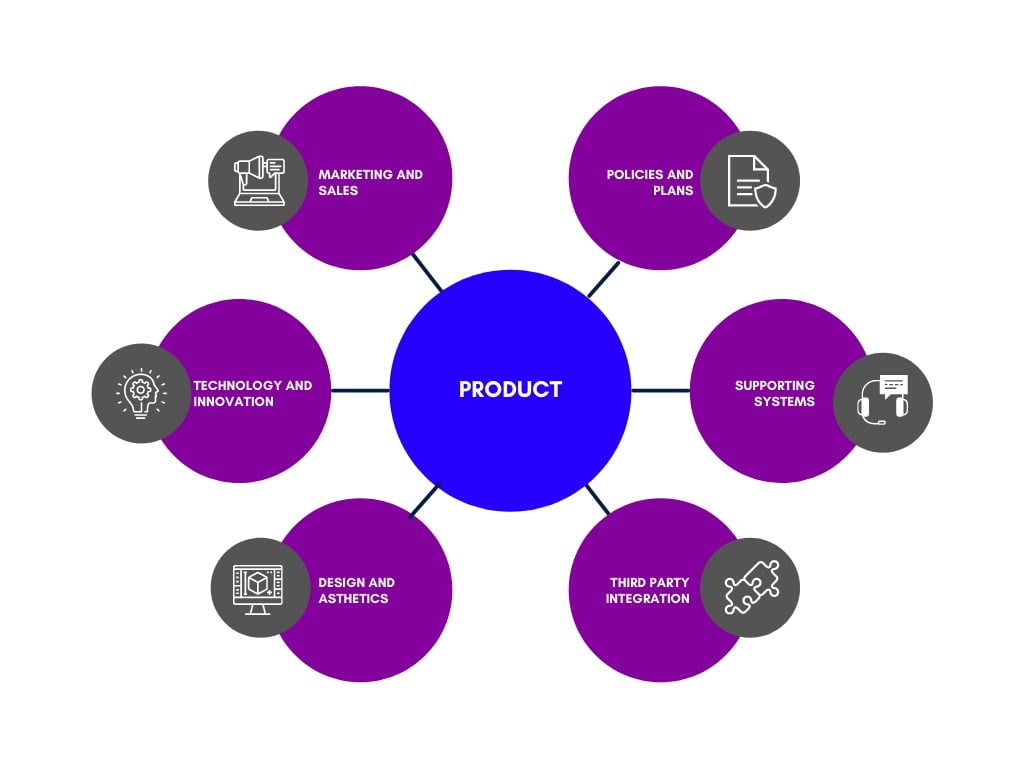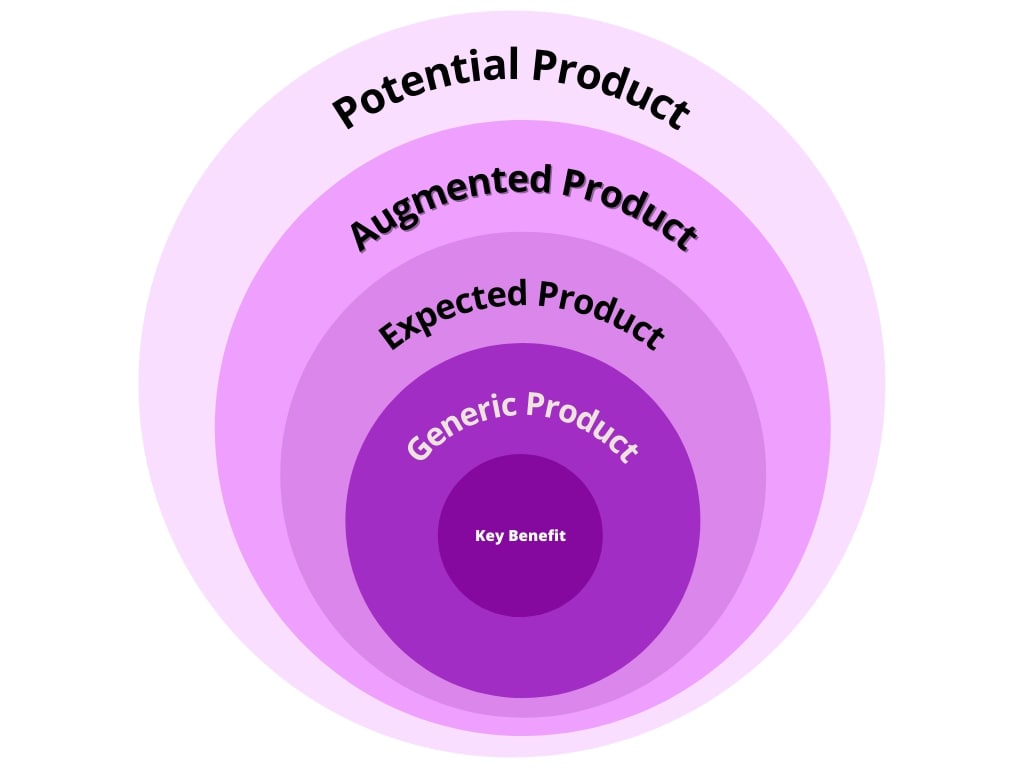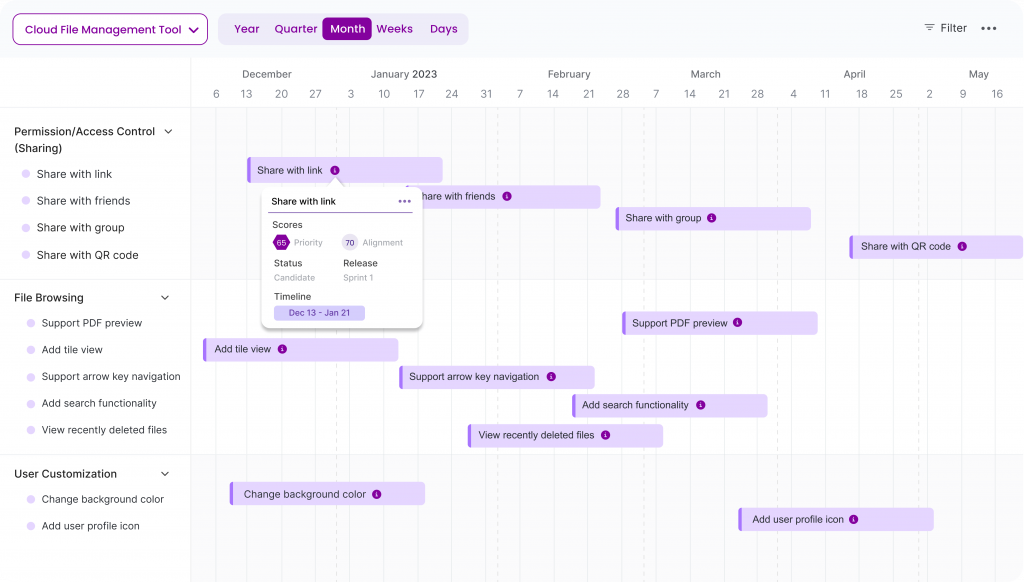What is a Product? (Definition, Meaning and Examples)

What Is a Product?
Product Definition:
A product is something sold to fulfill a customer’s desire or requirement, whether it’s tangible or intangible. Physical products can be either durable goods (such as furniture, cars, and electronics) or nondurable goods (such as food and drinks).
The world is full of products, which can take many forms.
The product meaning can extend to anything we use or interact with, ranging from food to clothing, soaps, and plants. Hence, product managers are one of the most necessary parts of a successful business.
Every business provides some level of product. Therefore, you need someone to manage those products. Every product manager must ask what they’re selling and who the buyers are.
Speaking of products, Chisel is your all-in-one solution if you want to craft amazing products for your business.
We help you with feature prioritization, team alignment, and customer feedback.
Try our free forever version today!
Crafting an amazing product begins by understanding whether it is physical or virtual.
When we think of a product, things that come to our mind are furniture, iPhones, or computers. We can call these physical products.
On the other hand, virtual products offer services such as mobile apps development, education, or software. These often include online products or services that you cannot access physically.
This new era of virtual products has changed the traditional ways of business. Thus, you see an increased demand for product managers. Many companies are beginning to utilize technology and offer hybrid products. These include both physical and virtual elements.
Moreover, we are seeing hybrid products reach and serve more customers. A great example is a video game, a physical and virtual product hybrid.
It requires you to own a computer or gaming console (physical) to access the game’s software (virtual).
Here, the product manager comes in.
They are responsible for planning and maintaining the product, whether physical or virtual, throughout its lifecycle. It takes more than fulfilling giving customers’ needs to earn their loyalty.
It would be best if you also thought about how all aspects of production affect customer satisfaction. These aspects include pricing, marketing strategy, and other factors like environment or design.
They may influence whether someone decides on one product over another.

What Are the Examples of Product?
While we’ve already provided an answer to the question of “What is a product?” perhaps a real-life example would aid in better comprehension. So, without further ado, let us look at an example.
Consider a new vehicle.
Dozens, if not hundreds, of computer chips control the vehicle’s engine, dashboard screen, and other electronic parts. Now, the vehicle is a product for the car user. Most automobile customers will never notice them. However, these computer chips are valuable to the automaker who develops the car and the technician who repairs it.
The inkjet printer is another excellent example.
Several companies began offering their printers for low prices several years ago. Some even provided them for free.
What’s the point?
These printers went out of ink every few hundred pages or months. As a result, the owners had to replace ink cartridges frequently during the year. We wrongly believed that the printer was the product we were ordering. The printer was more of a promotional tool to the firm that manufactured and supplied it. Ink cartridges were authentic products.
What are the Types of Customer Products?
There are several types of products in the market.
Some are new to marketing, some are new to the company, and some are so novel that they create new markets.
Products can target many segments. However, the two umbrella terms that cover a wide swath of products are Consumer and Business.
Products For Consumers
Consumer products are the first category classified by how they meet the need for which the user purchased them. In this case, the users don’t buy the product for its characteristics.
These are also known as Business-to-Consumer products (B2C).
The two major categories of consumer products are consumables and durables.
Consumable goods get used up when satisfying your needs.
For example, a thirsty person buys a bottle of Coca-Cola to quench their thirst. However, they must drink all its contents before enjoying it again.
Durable goods last longer without being consumed or worn out, for instance, clothing. On the other hand, service providers deliver good value with no physical assets at risk.
Remember that service providers are different from durable and consumable goods. Plus, the offerings of the like have expanded thanks to the advent of SaaS.
Very few ‘products‘ are purely service or purely tangible. Especially in the last decade, they generally involve some mix of services within the overall product offering.
Products For Business
Organizations buy business products to contribute their efforts toward an industrial objective.
Unlike household goods, business products are not purchased for personal consumption or enjoyment. They solely serve business-related plans.
These products are also known as Business-to-Business products (B2B). Economists consider these goods to be intermediate products.
It means the demand for this product will depend on the final market served by an organization.
This process is called derived demand.
That’s why industrial markets are subject to more fluctuations in demand.
A computer would be an excellent example of a business product. With remote work, a computer became necessary for every company.
Whichever type of product you decide to build, what is crucial is having a tool that assists you in creating product roadmaps, collecting feedback using user research tools, and so on.
We recommend you go for the best product management software, with the package of all tools needed to craft outstanding products.
Kotler’s 5 Product Level Model
Businesses need to tailor their products to satisfy customers’ needs and wants. However, that is a difficult task for companies with limited resources.
For many companies, it’s not cost-effective to customize each product by market segmentation. These segments can be regarding user preferences like prices, color, size, and so on.
Suppose these businesses have more flexibility in configuring goods, such as scaling production output. In that case, they will be better off at satisfying all consumer demands while maximizing profitability.
Philip Kotler, an economist, devised a model recognizing that customers have five levels of need.
They ranged from functional/core needs to emotional needs.
He established three drivers of how customers attach value to a product:
- Need: A lack of an essential requirement.
- Want: A specific requirement of products to satisfy a need.
- Demand: A set of wants plus the desire and ability to pay for the product.

Essentially, customers will buy products that best match their perceived value of the product. They are satisfied only if the measured worth matches/exceeds initial expectations.
Core Benefit
Core benefits are consumers’ fundamental needs to satisfy by consuming your product.
For example, suppose you’re designing a camera app. In that case, one of its core benefits is to provide digital photos to process users’ images anytime they want. If you’re wondering how to create an app, understanding and addressing these core benefits is a crucial first step.
Generic Product
A generic product is a version of the product containing those attributes or characteristics necessary to function.
For example, suppose you need to process digital images but do not have the time and money. In that case, free image processing software on a personal computer or a processing laboratory will suffice.
Expected Product
Every product has essential product features that buyers expect when they purchase it.
For example, the computer offers fast image processing and high-resolution accurate color screens.
Augmented Product
Augmented products are a cost-effective way to set your product apart from the competition.
They offer more than competitors with additional features, benefits, attributes, or related services.
For example, suppose you have preloaded image processing software for no extra charge. In that case, you make people feel like you’re looking out for them by including that feature in their purchase.
Potential Product
In the future, products will undergo transformations and augmentations just like now.
Businesses must aim to surprise customers with new upgrades and features, ensuring customer retention in product development.
An example would be updating the OS to include new features that make life better for the consumer.
Why Use the Kotler Model?
Kotler’s Five Product Level model helps marketers strategize for the best product mix to target various customer segments.
A company must categorize products into groups that correspond with specific needs. That way, they can keep their marketing efforts focused on meeting those niche demands of customers.
This practice prevents the company from spreading itself too thinly across a generalized consumer base. Kotler’s five-product level strategy is a beneficial product management tool.
It determines which stock-keeping units (SKUs) are most profitable for different clientele demographics. This strategy enables you to align sales processes and operational strategies with each customer segment.
Click here to understand your product operations better and implement this strategy.
The 5 Ps
What are the 5 Ps?
The 5 Ps are also known as the Marketing Mix.
The 5 P’s of marketing are place, price, product, promotion, and people.
They are the five pillars of a successful marketing strategy.
Initially, Edmund Jerome McCarthy, a marketing professor from Notre Dame, developed it. It was originally known as the 4 Ps. This format classified marketing activities into four dimensions, allowing marketers to improve best practices. This aided immensely in everything from creating interactive brochures to devising long term marketing strategies.
It incorporates sociology and psychology to enhance its insight into consumer behavior.
Understanding the 5 Ps is the key to any successful marketing campaign.
Product
As already discussed, products are a vital component in the success of every business.
Companies must study and understand all aspects of their product.
That includes how it impacts customers emotionally, physically, or mentally. Different products have different needs and desires that you must meet to sell well.
Companies should identify what these facets may be early on to make more informed decisions. It can help you choose their product strategy: whether it’s a physical or hybrid product.
No matter what type of good you offer, an important thing to remember is to understand your potential buyers.
Businesses must know who will buy their product before investing money, brainstorming ideas, or building prototypes. A seamless software for product managers promotes creativity, user acceptance testing (UAT), and innovative thinking that help create top-notch products..
People
At the heart of the 5 P’s are the customers.
It would be best if you considered them when strategizing for success as a marketer. Marketing is about recognizing the needs of your customer and satisfying them.
The engine that makes this happen?
People!
Every person in your organization should be able to answer any question a potential or current customer has. This responsibility lies with all the employees as much as customer support.
Every business needs good people to understand the people they’re working for to create an excellent customer experience.
Click here to learn how to shape your customer experience strategy.
Promotion
Promotion is more than advertising.
It’s the culmination of all your activities and methods to promote products or services.
With promotion comes costs, so ensure you’ve researched how well each method will do before investing. The cost can be high depending on what kind of media you want to use for marketing purposes. It will also help if you know who your target market is. You can promote your business in all sorts of ways, you could create social media video content, use paid ads (PPC), or improve your search engine presence using SEO.
This should affect which forms of promotion will work best when it comes to targeting.
Place
As they say in marketing, “It’s all about the location.“
Location is a massive influence because consumers aren’t actively shopping for your product or service. Consumers are strongly influenced by what’s currently available when they want something.
The place element helps get your product or service at the right time and place. You must ensure you price it competitively with quality that suits their needs. That leads to why people buy from one store or company over another, even if it has higher prices.
Price
Once you understand the product, pricing decisions can affect it.
Pricing determines profit margins, demand, supply, and a marketing strategy for any company or brand. Understanding what your customers value when comparing prices from other brands is essential.
Such a practice helps avoid being left out on a limb with your offers. The art of pricing comes to life through your customer’s lens.
Understanding what users value and how much it’s worth in their eyes will help you determine the price of any product.
To learn more about your customer journey map, click here.
This practice will lead you to your product-market fit and allow you to carve out your market niche.
How to Price a Product?
First: Find the base price of common pricing strategies in your industry
If you’re unsure how much to charge for your product, it’s best to research what prevailing prices are in the industry.
Suppose there is no information available online or if this doesn’t work. In that case, try looking at other products that offer similar benefits and see what they cost.
It will be worth checking competitors’ pricing strategies before setting yours. The price should reflect both fixed and variable costs incurred by the seller/creator of the product during the production process.
Then: Capture market share through pricing strategies
Pricing strategies are an excellent way to capture market share.
For example, suppose you have competitive goods and services. In that case, the lower prices will entice consumers into your store.
At the same time, higher price points are more suitable for luxury brands looking to attract an affluent customer base.
The pricing strategy is vital because customers won’t know how much they should pay without it. It can lead them away from making purchases that would benefit both parties in profit margin and consumer experience.
Lastly: Make sure product pricing drives long-term profit
There is no greater strategy for a company than ensuring its product pricing drives long-term profitability.
The keyword here, however, is “long term.”
Too many businesses look at short-term solutions. This only serves to drive the company into losses in the longer term.
It may seem like common sense. However, many companies don’t think before taking action on what appears as an attractive way to generate a quick profit.
Setting your first price.
To set your first price, find out what it takes to bring the idea for your product to market.
You need a break-even point that is more than just making enough money from each sale to cover costs and profit.
The costs need to include the costs of employees, marketing, product development, and more.
The Need for a Product Manager
Product managers play a critical role in developing software ,digital products and digital marketing products. The product manager’s responsibilities cast a wide net. They range from setting product vision to making feature roadmaps to meet company goals and user needs.
Product roadmap software is available for you, and product managers know how to make its best use.

The technology industry relies on guidance for every product’s lifecycle step. You should practice product management at an enterprise level for all the company’s products. You can also use it on a project basis that focuses on one type of product, such as software applications.
Product management is a complicated process that requires technical, business, and design expertise.
Product managers need to understand customer needs and what makes for an intuitive product experience. They must balance user-oriented product goals with bottom-line objectives while ensuring cost efficiency for their company.
Aspiring PMs should consider three primary factors when evaluating a role: core competencies, emotional intelligence (EQ), and company fit. The best PMs we’ve seen were the ones who mastered their core competencies and EQ skills.
They found work that matched them at an appropriate organization for growth opportunities. They are responsible for shipping new features regularly and keeping clarity among engineering team members and design.
They aim to deliver products that will positively impact user adoption rates of your product or disrupt an industry altogether.
Now that you know some of the basics about the product definition, product examples, and price, it’s time to tell you about Chisel.
What is Chisel?
It’s a product management software to balance the three pillars of product management: Product roadmapping, team alignment, and customer connection.
Our intuitive interface and powerful features allow anyone to create a roadmap for their product and align their team.
We like to say, ‘We use Chisel to build Chisel.’
Let us help take your idea from concept into reality. We want every entrepreneur worldwide to access this great platform so they can craft amazing products!
Click here for more information on our work and what makes us different.
You may also be interested in:
- What Is Product Planning? (Process and Importance)
- 6 Techniques for Finding Profitable Product Ideas
- What is Product Discovery? (Techniques and Tools)
- What Is a Product Portfolio and How To Build It?
- What Is the Product Launch Timeline?
- 11 Best Product Planning Software
- What Is Product Advertising? Definition, Types & Benefits
